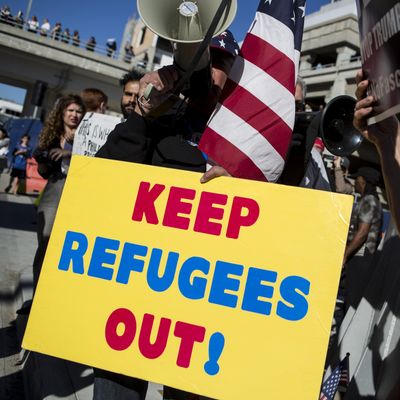
From 2005 to 2015, over 300,000 Americans were killed by guns; 94 were killed by jihadists.
The math is simple, as Jenny Anderson reports at Quartz: Americans are over 3,000 times more likely to be killed by a firearm than by terrorism. But the psychology is not so simple: Despite those stats, “terrorist attack on nation” and “victim of terrorism” both rank among the top five of Americans’ greatest fears, according to the 2016 edition of Chapman University’s Survey of American Fears. These same fears energize the Muslim travel ban: In the words of Rudy Giuliani, “instead of religion, danger!”
What this boils down to is a quirk in human reasoning uncovered by psychologists Amos Tversky and Daniel Kahneman, called the availability heuristic. “[A] person evaluates the frequency of classes or the probability of events by availability, i.e., by the ease with which relevant instances come to mind,” they wrote in a heavily cited 1973 paper. “In general, availability is correlated with ecological frequency.” The easier it is to think of something, the more likely you’ll think it is to happen.
This would be an accurate guide if the information we received about the world perfectly represented the contents of life, but the media-political discourse does not represent current events in the same way a map portrays a landscape. Rather, as media scholars have found time and again, people construct their models of the world though the media they consume, in line with the availability heuristic. You are what you eat; the world is what you see, hear, and read.
This is why Americans have also, since the early 2000s, thought that the crime rate was increasing, when in reality it was decreasing — until violence in Chicago and a handful of other cities started pushing it up.
Scholars call the product of it-bleeds-it-leads news cycles and violent entertainment Mean World Theory. Since the average kid sees 8,000 dramatized murders by the time they turn 12, they take the world to be more violent than it actually is.
It’s the same case with Muslims, terrorism, and the consequent Islamophobia. In an analysis of network and cable news shows from 2008 and 2012, communications scholars Travis Dixon and Charlotte Williams found that Muslims were greatly overrepresented as terrorists; they cite FBI stats finding that just 6 percent of terrorist acts in a separate four-year period were committed by Muslims, while 81 percent of terrorists on TV news were portrayed as Muslim.
This may be because, they argued, news programmers seek higher ratings, so “accurate representations of the real world are not the first goals of many news decision-makers.” Editors, trying to score well on metrics, select for images that draw in audiences, like the interfaith strife (Muslim terrorists) and interethnic conflict (undocumented Latino immigrants). As other scholars have noted, while climate change is almost certainly a bigger existential threat to humanity than terrorism, it just doesn’t make for as compelling television. And who reportedly loves TV news more than just about anyone else? President Donald Trump.




